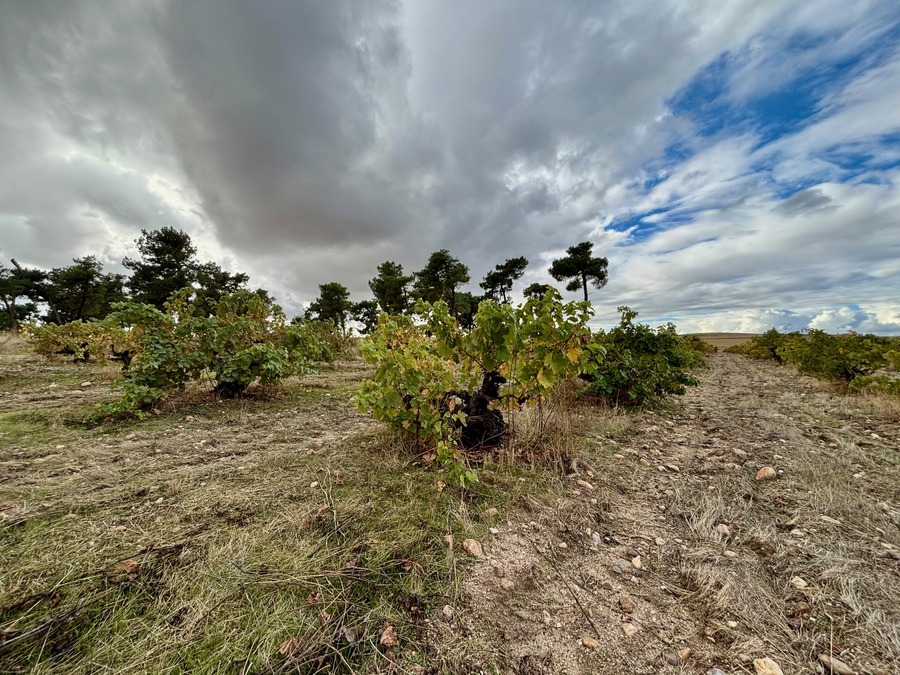Ossian Vides y Vinos
Cordel de las Merinas, s/n. 40447 Nieva (Segovia)
www.ossianvinos.com
This is an essential producer for white wine lovers. Vineyards are located in the province of Segovia (Castilla y León, northwest of Madrid) at an average elevation of 900m. They extend across Nieva, where the winery stands, and onto nearby villages such as Nava de la Asunción, Moraleja de Coca, Santiuste de San Juan Bautista, Bernuy de Coca, Villagonzalo de Coca, Aldeanueva del Codonal, Aldehuela del Codonal, Codorniz, Melque de Cercos and Ochando. All the vines lie within the Rueda appellation but the wines are sold as VT Castilla y León.
The project was launched in 2005 by local winegrower Ismael Gozalo and Javier Zaccagnini, former director of the Ribera del Duero’s Regulatory Board. At Ossian, their aim was to explore the huge potential of the extremely old Verdejo vines grown in this area of Segovia. The region’s sandy soils kept phylloxera at bay —it had little impact here.
Pre-phylloxera vines
In fact, this is one of Spain’s major strongholds of pre-phylloxera vines, where ungrafted plantings remained common until the mid-20th century. Wines from this area tend to be less overtly aromatic —expect white fruit and herbs rather than exotic fruit and herbaceous aromas), but they make up for it with structure and saline notes.
Since January 2016 the Ruiz family, owners of Pago de Carraovejas in Ribera del Duero, has been the sole proprietor. They first acquired Zaccagnini’s shares and part of Gozalo’s in 2013 and later bought the remaining stake from the Nieva-based winegrower.
From the outset, Ossian has stood out for its commitment to organic practices relying solely on natural compost and plant extracts. From the 2025 harvest onwards, Ossian will be certified biodynamic —a major step forward in deepening its understanding of the soils.
Vineyard development has been particularly ambitious. Starting with just a few hectares, the Ruiz family has consolidated 70 hectares of ungrafted vines aged between 100 and 120 years old, spread across numerous smallholdings. Additionally, 50 hectares were planted in Nieva between 2015 and 2022 using their own massal selections. These 15 plots of young vines are destined to the entry-level white Quintaluna and are all fermented separately in stainless steel tanks. With its distinctive sandy soils, Nieva is the coldest of the villages due to its proximity to the Guadarrama mountain range, a factor that imparts freshness and tension to the wines. Since 2022, Ossian has worked exclusively with its own vineyards.
Javier Blasco and Almudena Calvo are in charge of winemaking. Calvo, technical director at Pago de Carraovejas in Ribera del Duero, is responsible for the group’s red wines, while Blasco manages Marañones in Gredos and supervises the whites across the Alma Carraovejas portfolio. Both agree that Ossian endures the most extreme weather conditions of all the group’s projects. Spring frosts pose the greatest threat, devastating much of the 2017 and 2024 harvests, with losses reaching 90% in the latter. As a result, production can vary considerably, although the winery's average output stands at around 190,000 bottles.
The wines
In terms of winemaking, only natural yeasts are used in all Ossian wines. Quintaluna (15 €) is mainly aged in stainless steel tanks though a portion of oak-aged wine is sometimes included in the blend. The winery’s flagship wine, Ossian (50,000 bottles, €33), comes from pre-phylloxera and/or very old ungrafted vines. Aged for around nine months in a mix of 228-, 500- and 600-litre barrels as well as foudres, it is a Verdejo best enjoyed after two to four years of bottle age.
Capitel (1,500 bottles, around €115) is more exclusive and limited; it is a single-vineyard wine sourced from one of Ossian’s oldest plots in Cordel de las Merinas where distinctive schist patches lend a saline character.
Ossian unveiled its new winery in time for the 2025 vintage. Conceived as a contemporary reimagining of a Segovian village, the design arranges the buildings around a small square and makes extensive use of natural materials such as wood. Each space blends harmoniously into the surrounding landscape, framed by aromatic herb gardens —even on the rooftops of some of the buildings.
Most popular
NEWSLETTER
Join our community of Spanish wine lovers


